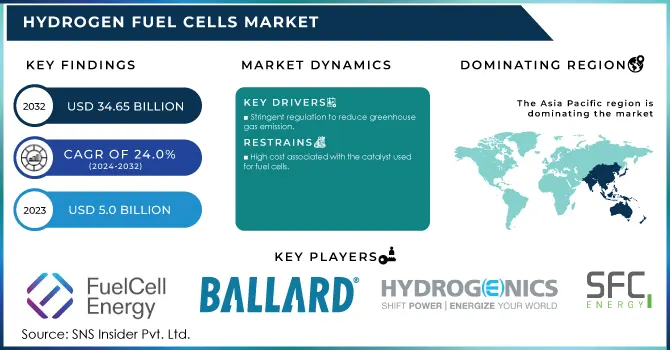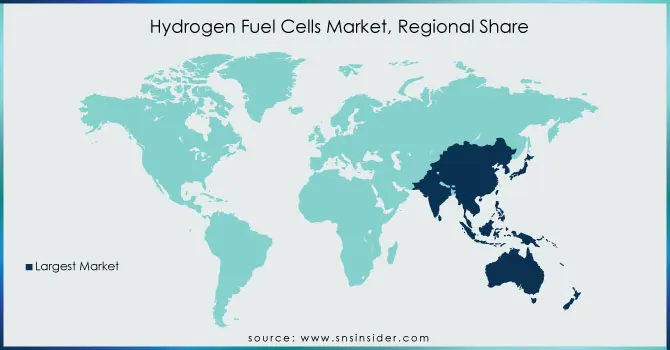Hydrogen Fuel Cells Market Report Scope & Overview:

To Get More Information on Hydrogen Fuel Cells Market - Request Sample Report
The Hydrogen Fuel Cells Market Size was valued at USD 5.0 billion in 2023 and is expected to grow to USD 34.65 billion by 2032 and grow at a CAGR of 24.0% over the forecast period of 2024-2032.
The hydrogen fuel cell uses the chemical energy from hydrogen and then efficiently produces electricity, water, and heat. Hydrogen fuel cells are unique because of their potential applications. They can provide electricity to large systems like utility power stations as well as small systems like laptops or computers. Hydrogen fuel cells combine hydrogen and oxygen atoms for electricity generation.
Demand for hydrogen as power plant fuel is growing therefore the USA’s power plant has announced plans to operate on a hydrogen fuel (natural gas) mixture in combustion gas turbines. For instance, In Ohio, the 485 MW Long Ridge Energy Generation Project facilitates the gas-fired combustion turbine which operates 95% on natural gas and 5% hydrogen fuel mixture in a gas turbine to produce a 100% green and renewable energy generation project.
Hydrogen fuel cells are also used in vehicles as an alternative to other fuels. Vehicles running on hydrogen fuel cells do not emit air pollutants which will affect the environment. The hydrogen fuel cell is two to three times more efficient than the internal combustion engine running on gasoline. Hydrogen fuel cell can facilitate the global decarbonization
Impact of COVID-19
The Covid-19 pandemic harshly impacted various industries with financial crises. Many small businesses closed their operation permanently and millions of workforces had lost their job due to stringent government regulations. Covid-19 impacted the automotive sector severely due to strict lockdowns and restrictions on traveling which reduces the use of fuel cells during this period. This reduced use of vehicles with stringent government regulations decreased the need for hydrogen fuel cells for the automotive sector.
Market Dynamics
Drivers
-
Stringent regulation to reduce greenhouse gas emission
-
Growing environmental concern about reducing pollution
-
Increasing demand for electric vehicles
-
Shifting consumer focus on renewable sources of energy
-
Decreasing reliance on fossil fuels
The growth of the hydrogen fuel cell market is mainly driven by the increasing need and demand for electric vehicles. Due to day-by-day increasing carbon gas emissions polluting the environment which has drawn the government’s attention to increase the use of electric vehicles. Another factor that influences the hydrogen fuel cell market is growing concern regarding environmental issues due to the over-exploitation of fossil resources. Reduced dependency on conventional fossil fuel energy has further boosted market growth.
Restrain
-
High cost associated with the catalyst used for fuel cells
-
Fluctuating raw material prices
The high cost of hydrogen fuel and volatile raw material prices of hydrogen fuel cells hampers the hydrogen fuel cell market growth.
Opportunities
-
Increasing government initiative to build hydrogen fuel cell infrastructure
-
Technological advancement
Challenges
-
High initial investment for the construction of infrastructure
Impact of Russia-Ukraine War:
Russia holds the title of the world's largest natural gas producer. However, the country is also exploring the potential of hydrogen fuel cells as a viable alternative to fossil fuels. Unfortunately, Europe has experienced the lasting effects of Russia's invasion of Ukraine, particularly in the hydrogen and energy sectors. The disruption of the supply chain for affordable Russian hydrogen or gas has forced Europe to invest more resources and funds into decarbonizing the environment and developing the hydrogen fuel cell market. This has resulted in a significant increase in effort and expenditure for Europe, but it is a necessary step towards a more sustainable future.
Impact of Recession:
The global economy has been hit hard by the recent recession, and the hydrogen fuel cell market is no exception. The recession has had a significant impact on the growth and development of this market, affecting both the supply and demand sides of the equation.
On the supply side, the recession has led to a decrease in investment and funding for hydrogen fuel cell research and development. This has resulted in a slowdown in the production and commercialization of hydrogen fuel cell technology, as companies struggle to secure the necessary resources to continue their work.
On the demand side, the recession has led to a decrease in consumer spending and a shift towards more cost-effective energy solutions. This has resulted in a decrease in demand for hydrogen fuel cell vehicles and other applications, as consumers and businesses prioritize affordability over sustainability.
Regional Analysis
Asia Pacific region dominated the hydrogen fuel cell market and is expected to grow significantly during the forecast period. This growth is attributed to the growing population, increasing per capita income, and increasing demand for energy from this region. Rapid industrialization led to extreme pollution in developing economies. Hydrogen fuel cell is the best alternative to conventional fossil fuel energy sources which help to decrease carbon gas emissions and efficiently satisfy the growing need of the population. China’s hydrogen fuel cell market is the largest fuel cell market and India is the rapidly growing market in this region.
Europe is expected to show lucrative growth during the forecast period owing to the increasing user base. The increasing adoption of strict regulations for reducing pollution and greenhouse gas emissions led to an increase in the demand for hydrogen fuel cells in this region.
North America region also accounted for a significant revenue share. Increasing Research and Development activities regarding fuel cells, and the presence of key market players are the main factors that drive the growth of the hydrogen fuel cell market.

Do You Need any Customization Research on Hydrogen Fuel Cells Market - Enquire Now
Key Players
The major players are FuelCell Energy Inc., Ballard Power Systems, Hydrogenics Corporation, SFC Energy AG, Nedstack Fuel Cell Technology B.V., Bloom Energy, Doosan Fuel Cell America, Inc., Ceres Power Holdings PLC, Plug Power, Inc., Nuvera Fuel Cells LLC, and other key players mentioned in the final report.
| Report Attributes | Details |
| Market Size in 2023 | US$ 5.0 Billion |
| Market Size by 2032 | US$ 34.65 Billion |
| CAGR | CAGR of 24.0% From 2024 to 2032 |
| Base Year | 2023 |
| Forecast Period | 2024-2032 |
| Historical Data | 2020-2022 |
| Report Scope & Coverage | Market Size, Segments Analysis, Competitive Landscape, Regional Analysis, DROC & SWOT Analysis, Forecast Outlook |
| Key Segments | • By Product Type (Liquid-Cooled Type and Air-Cooled Type) • By Technology Type (Polymer Exchange Membrane Fuel Cells (PEMFC), Phosphoric Acid Fuel Cells (PAFC), Solid Oxide Fuel Cells (SOFC), Direct Methanol Fuel Cells (DMFC), Molten Carbonate Fuel Cells (MCFC), and Others) • By Application (Stationary, Transportation, Portable) • By End-user (Fuel Cell Vehicles, Utilities, Defense) |
| Regional Analysis/Coverage | North America (USA, Canada, Mexico), Europe (Germany, UK, France, Italy, Spain, Netherlands, Rest of Europe), Asia-Pacific (Japan, South Korea, China, India, Australia, Rest of Asia-Pacific), The Middle East & Africa (Israel, UAE, South Africa, Rest of Middle East & Africa), Latin America (Brazil, Argentina, Rest of Latin America) |
| Company Profiles | FuelCell Energy Inc., Ballard Power Systems, Hydrogenics Corporation, SFC Energy AG, Nedstack Fuel Cell Technology B.V., Bloom Energy, Doosan Fuel Cell America, Inc., Ceres Power Holdings PLC, Plug Power, Inc., Nuvera Fuel Cells LLC |
| Key Drivers | • Stringent regulation to reduce greenhouse gas emission • Growing environmental concern about reducing pollution |
| Market Opportunities | • Increasing government initiative to build hydrogen fuel cell infrastructure • Technological advancement |

